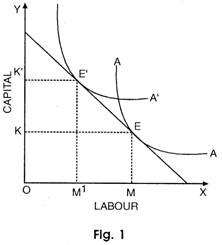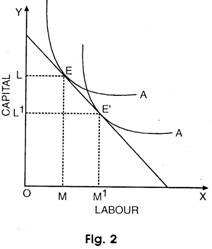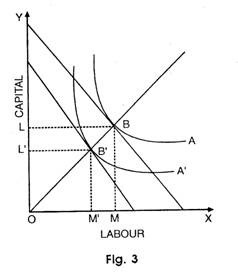The following points highlight the three main types of technical changes in agriculture.
Agriculture # 1. Land-Augmenting Technological Change:
As is known land is inelastic in its supply, therefore, some techniques might help to augment land availability.
Multiple cropping, fertilizers, pesticides, high yielding variety seeds are such techniques. Suppose an individual possesses 5 hectares of land and he is cultivating paddy. It takes six months to harvest because it is a traditional variety of paddy.
Now assume that the farmer adopts a High Yielding Variety, the duration of which is only three months, then he can cultivate twice and the area cultivated by the individual increases to 10 hectares. Thus, the biological, chemical and technical changes introduced in agriculture are referred as land-augmenting technological change.
Agriculture # 2. Labour-Saving Technical Change:
ADVERTISEMENTS:
All mechanised changes, like the use of tractors, threshers, etc. are called labour-saving. Similarly, some other inputs like the use of weedicides are labour displacing. In other words, the utilisation of labour in relation to capital becomes less when technological change is labour-saving. This fact can more precisely by elaborated with the help of Fig. 1.
In the figure after technical change, the isoquant shifts from A to A’. The constant factor prices call for less labour and more capital after technical change.
The amount of labour declined from OM to OM’ whereas the amount of capital used increased from KE to K’E’ i.e. the capital-labour ratio increased. This kind of change tends to increase the marginal product of capital more than marginal product of labour.
Agriculture # 3. Capital-Saving Technical Change:
ADVERTISEMENTS:
In the case of capital-saving technological change, the capital-labour ratio declines. As is clear from Fig. 2 that before technical change, the isoquant is A and the capital and labour used are LE and OM. After technological change the isoquant is A’ and the capital and labour used are M’E’ and OM’. Here, capital-labour ratio declines. This kind of change tends to increase the marginal product of labour more than marginal product of capital.
Agriculture # 4. Neutral-Technical Change:
In this case, capital-labour ratio remains constant after technical change. In the fig. 3 isoquant A is the situation before technological change, OL of capital and OM of labour is used to produce the level of output represented by isoquant A. After the technological change isoquant shifts downwards.
With less capital (OL’) and less labour, (OM’) the same output can be produced. However, the capital-labour ratio (OL/OM) before technological change and capital labour-ratio (OL’/OM’) after technical change are equal.
Now we divert our attention from the kinds of technological change to New Agricultural Strategy with particular reference to India.


